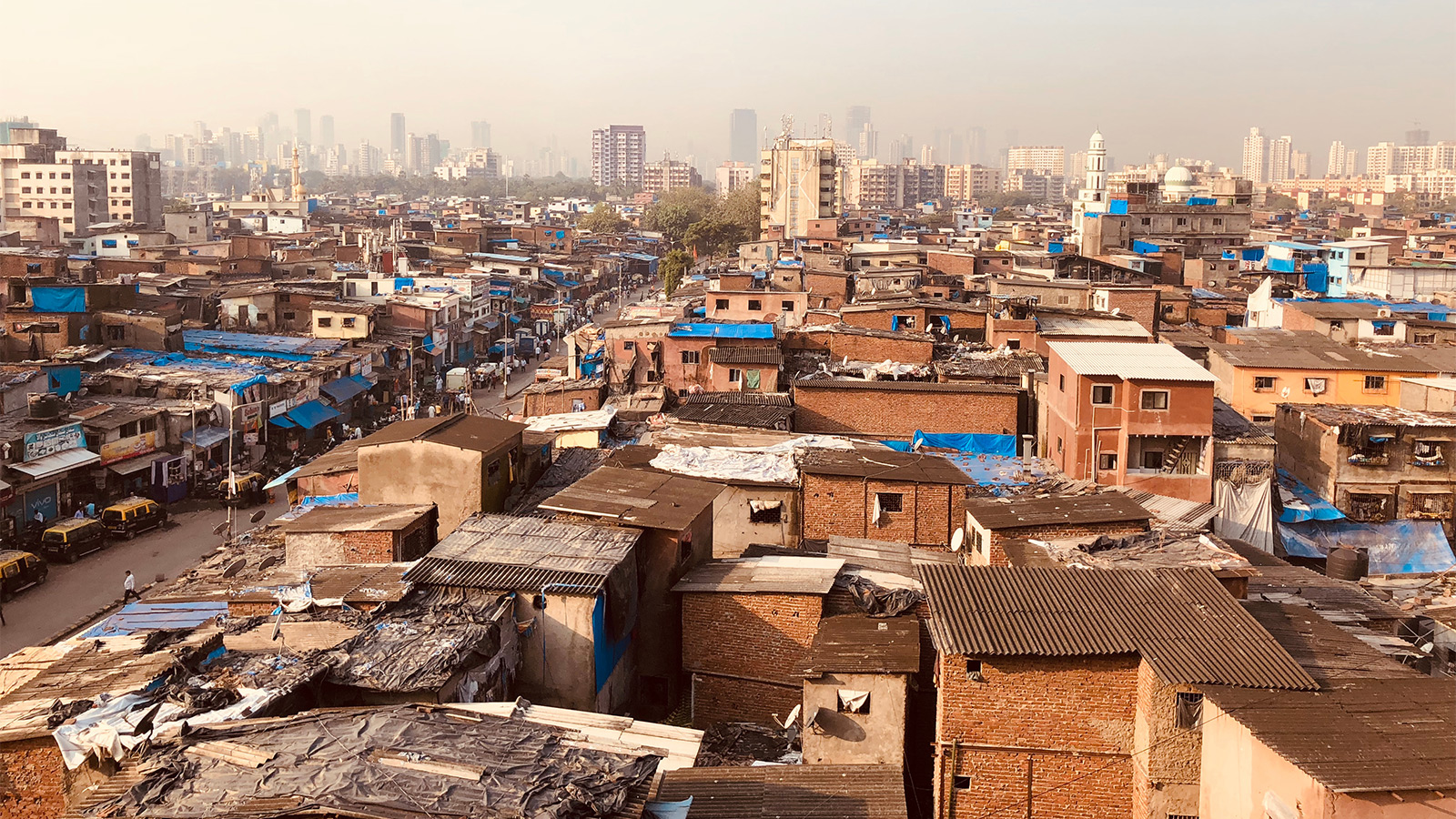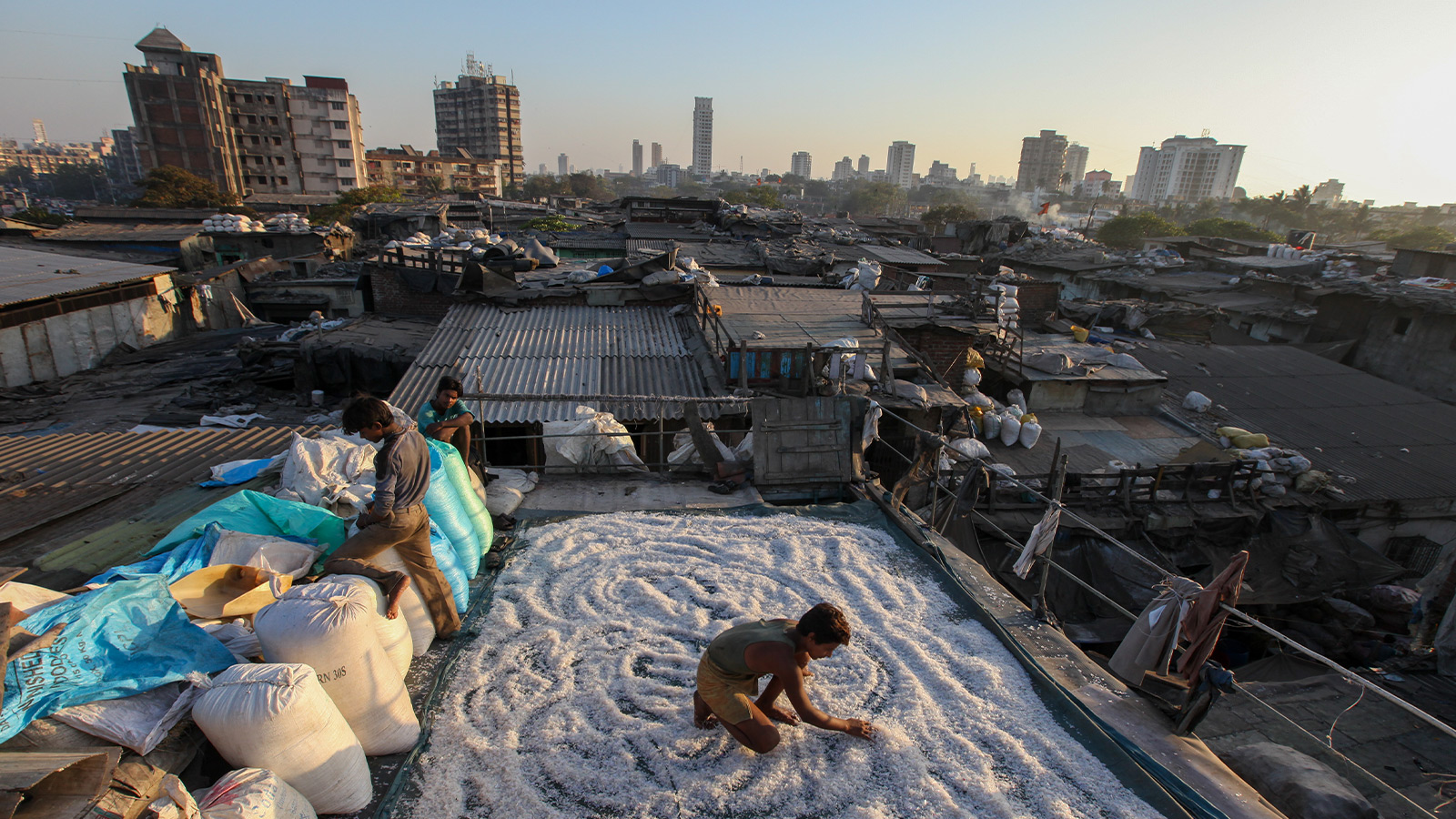When Sourav Dey, originally from Calcutta, travelled to the Mumbai slum of Dharavi for his MSc architecture thesis in 2018, he found it teeming with industry.
“In the recycling shacks, people sit in waist-deep piles of car batteries, computer parts, fluorescent lights, plastic bags, paper, cardboard boxes, and wire hangers. Each item is sorted for recycling. There are workshops in which aluminium smelters recycle drink cans. People stir huge vats of waste soap retrieved from rubbish tips and local hotels. One-gallon oil cans are cleaned and hammered back into shape. Then they are sold back to the oil companies and local consumers”.
India’s largest slum seems an unlikely poster child for the country’s sustainability drive. Most of the 5,000 often windowless single-room recycling units across Dharavi’s poorly sanitised 520 acres (2.1 km2), operate without government oversight or regulation, many illegally. The 30,000 Dharavi “rag pickers” who work in them – sorting, sifting, melting and recycling thousands of tonnes of waste material every day – enjoy few protections. Many are children, nearly all are without formal employment contracts or safeguards; their workplaces escape basic building or workplace safety checks and the sanitation is basic or absent. Unwanted chemical and solid waste is often dumped in local watercourses; melting down plastics or burning off chemicals and producing noxious fumes.
But by some estimates the rag pickers collectively recycle up to 80% of the dry waste discarded by Mumbai’s 20 million inhabitants, whose daily 11,000 tonnes of trash makes the city the most wasteful in India. Plastic, glass, electronic waste, metal, tetra pacs, cardboard and paper is bundled up and repurposed, some of it fashioned into improvised building material to house Dharavi’s nearly 1 million inhabitants, many of whose homes double as their work places.
About to undertake an unparalleled building boom, India badly needs a more sustainable construction model. Construction accounts for less than 10% of the country’s economy but roughly a quarter of its greenhouse gas emissions. Both numbers are set to rocket to accommodate India’s rapid urbanisation that, by 2050, will see 60% of its population housed in cities. And 70% of the country’s building stock to be used by 2030 is still unbuilt. The principles of the circular economy on show in Dharavi could play a vital role.
Most of the construction industry on which India’s urbanisation will rely, operates a lot like Dharavi’s rag pickers. By government estimates, 76% of its companies occupy the so-called informal economy – paid in cash, unregistered and unregulated, denying workers basic employment rights or safety protection.
In the demolition sector – comprised in part by a web of independent operators scouring sites for reusable building components and selling them on for re-use – the proportion is likely to be much higher, says Avikal Somvanshi, analyst at Delhi-based thinktank Centre for Science and Environment (CSE) and author of a Another brick off the wall, a 2020 report on construction and demolition (C&D) waste in Indian cities. “Municipal and national governments don’t maintain a registry of these services.”
“With growing urbanisation, there will inevitably be a construction and demolition boom, but the key agents responsible for managing this waste have been totally ignored” Avikal Somvanshi, Centre for Science and Environment
Recycling in building
Despite being crucial to the sustainability of India’s current construction boom, the informal C&D is almost entirely ignored by India’s central government. Official numbers estimate one-quarter of the material from an old building (60 years or more), and three-quarters of those from a new one (anything younger), can be recovered for re-use. But the 2016 regulation that introduced a legal framework for the industry, India’s first set of rules mandating the handling, management and recycling of the waste generated from C&D, failed even to mention the informal sector.
“With growing urbanisation and construction of buildings and infrastructure, there will inevitably be a C&D waste boom, but the key agents responsible for managing this waste have been totally ignored,” says Somvanshi.
How much waste is generated by India’s construction industry remains unclear. An official estimate from 2000 for C&D waste persisted in government documents until 2015, despite a massive construction boom over the period. Cement production grew by 11% per year between 2004 and 2012; and construction employment by 9% between 2006 and 2012, reaching 56 million by 2020.
Demolition contractors, the anchor of this informal circular economy, have established a thriving profession that feeds the informal market of recovered building materials and provides hundreds of thousands of jobs, according to Somvanshi.
“The typical practice is more like deconstruction than demolition, they will literally take the building apart,” he says. Salvaged materials include doors and windows, glass panels, partitions, furniture, bathroom fixtures, pipes, electric equipment and wires. Steel reinforcement and bricks are retrieved during demolition. Debris – the mess of soil concrete and broken bricks – is the only waste component that is not immediately fit for re-use, requiring instead specialised recycling plants that operated largely outside demolition’s informal sector.
Despite its importance, key players in the country’s construction market have little grasp of how it works. “It is specialised activity of which architects and builders have little understanding, with small players that generally neither have professional expertise nor are registered with [municipal authorities],” notes Another brick off the wall.

Wasted disposal rules
Local rules, meanwhile, often prevent India’s demolition sector from working at all. In Gurugram, a satellite city of more than a million people, south west of the capital New Delhi, permit rules require construction companies to estimate the amount of waste their project will create when applying for the permit. Unless they deposit an equivalent amount to the municipal disposal facility – a privately run facility focused on recycling rather than re-use, using modern crushing machines – they are fined.
The focus on recycling misses many objects that may be salvaged more cheaply and efficiently – why crush a secondhand brick to recycle it, if it is useable in its current form? Salvage is harder once materials have been mixed up in loads and dumped at the disposal facility, a process that may damage them irreparably.
“Cutting out the informal demolition companies deprives thousands of their livelihoods. This is the bread and butter of a large and economically precarious section of society, just like the waste pickers of municipality,” says Somvanshi, adding that examples like Gurugram are increasingly common. It also increases the amount of waste that site contractors are required to collect and transport, which increases their costs.
Hobbling opportunities for re-use of building materials makes India’s dumping problem worse. “To cut corners and save costs, building contractors often dump unwanted waste on unused land parcels, often in environmentally sensitive areas, near creeks, or reclaiming marsh land illegally,” says Viswajit Srinivasan MRICS of Ananya Capital Advisors, a boutique investment bank in Mumbai, specialising in real estate. Even where government rules make such dumping illegal, corruption often sees it go unpunished. “The governing bodies, contractor and developers are all aligned. The policy level is one thing, but there is widespread corruption and disregard for environmental norms and standards.”
Things are little better for India’s nascent formal recycling market, which has been disabled by a punitive tax treatment. New materials such as bricks are taxed as aggregates at 5%, compared to products manufactured from recycled C&D waste – such as recycled concrete blocks – which are taxed at 18%.
“To cut corners and save costs, building contractors often dump unwanted waste on unused land parcels, often in environmentally sensitive areas, near creeks, or reclaiming marsh land illegally” Viswajit Srinivasan MRICS, Ananya Capital Advisors
Cost benefits
Despite such obstacles, pilot projects have demonstrated that construction projects based on recycling are cheaper, according to Somvanshi. He points to the extension of India’s Supreme Court building in Delhi, completed in 2018, which purchased 1.8 million blocks from the city’s formal waste-recycling facility. Thanks in part to the taxes, the bricks cost more, but because architects and builders could specify the design and dimensions they needed, the total cost was the same as using new ones.
East Kidwai Nagar, a recent 86.5 acre (35 ha), residential-led project in the south of the city avoided the punitive tax treatment by recycling demolished materials on site. Spoiled bricks and concrete from the demolition went into a small crushing unit, which saved on transport and procurement costs of sourcing new materials. The informal re-use companies picked off doors, windows and plumbing.
Without the financial heft and connections of the Central Public Works Department of India, the authority responsible for the Supreme Court building, few contractors can harvest similar economies of scale. Appreciation of the favourable economics has not yet filtered down to the stakeholders responsible for procurement, and the industry is notoriously slow-moving. “Awareness is still very low in the construction industry, even architects are not aware of it. That’s a major roadblock. The expertise and tech to do it is limited. Not many entrepreneurs are involved. And there is general inertia in both the public and private sectors,” says Somvanshi.
Meanwhile, recycling and re-use are conspicuous by their absence in the Indian government’s major housebuilding initiative. In 2015, Indian prime minister Narendra Modi launched Pradhan Mantri Awas Yojana (PMAY), an initiative to build 20 million houses for the country’s urban poor by March 2022. Despite considering prefabrication technologies and other sustainable building approaches, the initiative rejected them on cost grounds, says Christopher Gomes MRICS, head of design at JP Infra, a leading Mumbai developer. “The sustainable building approach is cheaper when you count in the running costs over the life cycle of the buildings, but in this case everyone is just talking about initial costs. A different mindset is needed.”
He says that consumer preferences for new materials mean that government regulation enforcing more sustainable materials will be needed for the private home sector. “We have been unsuccessful in reusing material in construction, especially at the lower end because of the aspirational value of new materials. People want something new, old is not desirable. Unless the government intervenes with a regulatory framework, then it remains impossible.”
“The sustainable building approach is cheaper when you count in the running costs over the life cycle of the buildings, but everyone is just talking about initial costs. A different mindset is needed.” Christopher Gomes MRICS, JP Infra
Best practice
Stranded outside India’s formal economy, and unrecognised by major public and private construction projects, the potential for the C&D sector to make building more sustainable is limited. However, the example of India’s rag pickers provides a route map.
Twenty years ago when the Indian government first introduced a legal framework for solid waste, waste pickers and informal recyclers like those in Dharavi were ignored. Thanks to a combination of activism and labour initiatives – with many forming cooperatives and striking formal deals with local city authorities – the sector was recognised in the 2016 rules.
The city of Pune, 100 miles inland of Mumbai, shows the benefit of informal sector activism. In 1993, the city’s workers formed India's first rag pickers union. Today the union claims 9,000 members – 80% of whom are women from marginalised communities – processing more than 1,000 tonnes of waste per day, one-fifth of which is diverted from landfill.
Besides securing better pay and working rights for members, giving rag pickers formal contracts helped unlock loans, with which they invested in their homes, adding rooms or buying cookers or televisions that they previously could not afford. In the mid-2000s, the union spawned Swach, a workers’ cooperative that subsequently struck a contract with the city authorities for door-to-door waste collection.
Since COVID-19 hit, such organisation has enabled rag pickers – among India’s most vulnerable front-line workers – to campaign for better protection. By August 2020, having worked through lockdown on half pay without the COVID-19 dues extended to other essential workers, 3,500 members of Swach began socially distanced protests in the city. “They have all been turning up for work regardless of the threat. If they didn’t come, the waste collection system would collapse in the city,” Lakshmi Narayan, co-founder of Swach, told Indian national daily The Hindu, at the time.
Partly thanks to initiatives like these and partly to rag pickers’ ubiquitous visibility to Indian voters, on regular rounds collecting refuse across India’s largest cities, their cause is progressing. Left out of national regulations governing the treatment of municipal solid waste in 2000, they were included in 2016.
For India’s informal C&D workers, left out of those same regulations, the path is likely to be harder. They are a less visible group, toiling on building sites away from public view and with little public profile. They face vested interests in the construction industry, where an increasing number of large urban developers on major projects have locked out small re-use contractors because it is quicker to bulldoze and scrap entire sites. But the prize could hardly be more valuable.
“What took rag pickers 15 years to achieve is now just beginning for C&D workers. With growing urbanisation there will inevitably be a C&D waste boom, putting enormous strain on India’s dwindling repository of natural reserves. At the same time building waste destroys the fragile ecology and contaminates the air. India’s informal C&D sector is a crucial part of the solution,” says Somvanshi.
“The rag pickers have all been turning up for work regardless of the threat of COVID-19. If they didn’t come, the waste collection system would collapse in the city.” Lakshmi Narayan, Swach



